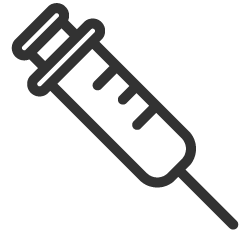A glowing, youthful complexion is the ultimate goal in skincare. Retinol and tretinoin are two powerful ingredients that can help achieve this. Known for their ability to transform skin by reducing fine lines and treating acne, they are staples in many of our clients skincare routines. But choosing the right one and knowing how to use it can be tricky.
This guide explores the benefits of retinol and tretinoin, their differences, and how to incorporate them into your skincare routine. Whether you’re new to skincare or looking to refine your regimen, this article will provide the insights needed to make the best choice for your skin. Let’s dive into the world of retinol and tretinoin and unlock the secrets to radiant skin.
Understanding Retinol and Tretinoin
What is Retinol?
Retinol, a derivative of vitamin A, is a popular ingredient in over-the-counter skincare products. It works by accelerating cell turnover, which helps to improve skin texture, tone, and overall radiance. Retinol is known for its ability to penetrate the outer layer of the skin, promoting the production of new skin cells and collagen, which are essential for maintaining youthful-looking skin.
Retinol is available in various concentrations, making it suitable for different skin types and concerns. It is often found in serums, creams, and lotions and is known for its versatility and effectiveness in treating a range of skin issues from fine lines to hyperpigmentation.
What is Tretinoin?
Tretinoin, also known as all-trans-retinoic acid, is a more potent derivative of vitamin A. It is a prescription-strength medication commonly used to treat severe acne and visible signs of aging. Unlike retinol, tretinoin is already in its active form, which means it works more quickly and efficiently.
Tretinoin accelerates the skin’s natural exfoliation process, promotes collagen production, and helps to unclog pores. This results in smoother skin texture, reduced wrinkles, and a more even skin tone. Due to its potency, tretinoin is typically recommended for individuals with more advanced skin concerns or those who have not seen results with over-the-counter retinol products.
Key Differences Between Retinol and Tretinoin
While both retinol and tretinoin are derived from vitamin A and offer similar benefits, there are key differences in their strength, efficacy, and availability:
- Strength and Efficacy: Tretinoin is significantly stronger than retinol. This means it can deliver faster and more noticeable results, but it also carries a higher risk of irritation and side effects.
- Conversion Process: Retinol must be converted into retinoic acid within the skin before it becomes effective, whereas tretinoin is already in its active form and does not require this conversion.
- Availability: Retinol is available over-the-counter in various concentrations, making it accessible to a wide range of users. Tretinoin, on the other hand, requires a prescription due to its potency and potential side effects.
- Skin Tolerance: Retinol is generally gentler on the skin and better suited for individuals with sensitive skin or those new to retinoids. Tretinoin is more suitable for those with resilient skin or more severe skin concerns.
Understanding these differences is crucial in deciding which product is best suited for your skincare needs. In the next sections, we’ll explore the specific benefits of each ingredient and how to incorporate them into your routine for optimal results.
The Benefits of Retinol
Improved Skin Texture and Tone
Retinol works by increasing cell turnover, which helps to shed dead skin cells and reveal fresh, new skin underneath. This process significantly improves the texture and tone of your skin, making it appear smoother and more radiant. Regular use of retinol can also help to minimize the appearance of pores, giving your skin a more refined look.
Anti-Aging Properties
Retinol is celebrated for its ability to combat signs of aging. It stimulates collagen production, which is essential for maintaining skin elasticity and firmness. By boosting collagen levels, retinol reduces the appearance of fine lines and wrinkles, helping to maintain a youthful look. Additionally, retinol can fade age spots and other forms of hyperpigmentation, contributing to a more even skin tone.
Acne Treatment
Retinol is highly effective in treating and preventing acne. It works by unclogging pores, which helps to prevent the formation of new acne lesions. Its anti-inflammatory properties can also reduce the redness and swelling associated with active acne. Over time, consistent use of retinol can lead to clearer, healthier skin.
Hyperpigmentation Reduction
Hyperpigmentation, such as sunspots, melasma, and post-inflammatory hyperpigmentation, can be effectively treated with retinol. By promoting the turnover of skin cells, retinol helps to fade dark spots and even out skin tone. This makes retinol an excellent choice for those looking to brighten their complexion and reduce the visibility of discoloration.
Enhanced Absorption of Other Skincare Products
Retinol helps to prepare the skin by removing dead skin cells and increasing cell turnover, which can enhance the absorption of other skincare products. This means that your serums, moisturizers, and treatments can penetrate deeper into the skin, making them more effective.
Benefits of Tretinoin
Powerful Anti-Aging Effects
Tretinoin is known for its potent anti-aging benefits. It works by increasing the production of collagen and elastin, which are crucial for maintaining the skin’s structural integrity. This leads to a significant reduction in fine lines, wrinkles, and sagging skin. Tretinoin also thickens the dermis, the deeper layer of skin, which contributes to a more youthful and resilient complexion.
Effective Acne Treatment
Tretinoin is a gold standard in acne treatment. Its ability to rapidly accelerate cell turnover helps to clear out clogged pores and prevent new acne formations. Tretinoin also reduces inflammation, which can help to calm existing acne breakouts and prevent future ones. For individuals with persistent or severe acne, tretinoin offers a highly effective solution.
Reduction of Hyperpigmentation
Tretinoin is highly effective in reducing hyperpigmentation. By speeding up the skin’s natural exfoliation process, tretinoin helps to fade dark spots, melasma, and other forms of hyperpigmentation. This results in a more even and brighter skin tone, making tretinoin a popular choice for individuals dealing with discoloration issues.
Improvement in Skin Texture and Tone
Tretinoin significantly improves skin texture and tone by promoting the turnover of old skin cells and the growth of new ones. This results in smoother, more even skin. The enhanced cell turnover also helps to refine the skin’s surface, minimizing the appearance of pores and giving the skin a more polished look.
Prevention of Future Skin Damage
Regular use of tretinoin can help to prevent future skin damage caused by environmental factors such as UV exposure. By promoting the production of new, healthy skin cells and increasing the skin’s resilience, tretinoin helps to build a stronger defense against the damaging effects of the sun and pollution.
Comparing Retinol and Tretinoin
Efficacy and Speed of Results
Retinol and tretinoin both deliver impressive results, but the speed and efficacy of these results can vary. Tretinoin, being the more potent of the two, often produces visible improvements more quickly. Users might notice changes in their skin texture and tone within a few weeks of consistent use. Retinol, while effective, generally takes longer to show results due to its lower strength and the need for the skin to convert it into its active form.
However, this rapid efficacy comes with a trade-off. Tretinoin is more likely to cause irritation, redness, and peeling, especially during the initial weeks of use. Retinol, on the other hand, is gentler and better tolerated by most skin types, making it a suitable option for those with sensitive skin or those new to retinoids.
Side Effects and How to Manage Them
Both retinol and tretinoin can cause side effects, particularly when first introduced into a skincare routine. Common side effects include dryness, redness, peeling, and increased sensitivity to sunlight.
- Retinol: Side effects with retinol are typically milder. To manage these, it’s recommended to start with a lower concentration and gradually increase usage. Applying retinol every other night and using a good moisturizer can also help mitigate irritation.
- Tretinoin: The side effects of tretinoin can be more pronounced. It’s essential to follow a dermatologist’s guidance when using tretinoin, starting with a low concentration and slowly increasing frequency as the skin builds tolerance. Using a rich moisturizer and applying tretinoin over it can buffer its strength and reduce irritation. Additionally, always use sunscreen during the day, as both retinoids can increase sun sensitivity.
Suitability for Different Skin Types and Conditions
Choosing between retinol and tretinoin largely depends on your skin type and the specific skin issues you’re aiming to address.
- Retinol: This is ideal for individuals with sensitive skin or those new to retinoids. It’s effective for mild to moderate signs of aging, uneven skin tone, and minor acne. Retinol is also suitable for those who prefer over-the-counter products and want a more gradual improvement with minimal side effects.
- Tretinoin: Tretinoin is best for individuals with more resilient skin or those dealing with severe acne, pronounced wrinkles, or significant hyperpigmentation. Due to its potency, tretinoin is often prescribed for those who have not seen desired results with over-the-counter retinol. It’s also a good option for those looking for faster, more dramatic improvements in their skin condition.
Long-Term Benefits and Considerations
Both retinol and tretinoin offer long-term benefits when used consistently. Retinol can maintain youthful skin and prevent early signs of aging with minimal risk of side effects. Tretinoin, with its higher potency, can provide substantial improvements in skin texture, tone, and clarity over the long term.
However, the key to long-term success with either ingredient is consistency and patience. It’s important to give your skin time to adjust and to use these products as part of a comprehensive skincare routine that includes moisturizers and sun protection.
In the next sections, we will discuss how to incorporate retinol and tretinoin into your skincare routine effectively and safely to maximize their benefits.
Incorporating Retinol into Your Skincare Routine
Tips for Beginners: How to Start Using Retinol
Starting retinol can be intimidating due to its reputation for causing initial irritation. However, with a strategic approach, you can minimize side effects and maximize benefits.
- Start Slow: Begin with a low concentration of retinol, such as 0.25% or 0.5%. Apply it two to three times a week to allow your skin to build tolerance.
- Patch Test: Perform a patch test before full application to ensure your skin doesn’t react adversely.
- Apply at Night: Retinol makes your skin more sensitive to sunlight, so it’s best applied at night. Always follow with sunscreen during the day to protect your skin.
- Use a Pea-Sized Amount: A small amount is sufficient. Apply it evenly across your face, avoiding the eye area and corners of the mouth.
- Moisturize: Follow retinol application with a gentle moisturizer to combat dryness and irritation.
Ideal Products and Concentrations for Different Skin Concerns
Choosing the right retinol product and concentration is crucial for addressing specific skin concerns effectively.
- Anti-Aging: For fine lines and wrinkles, start with a 0.5% retinol serum or cream. Gradually increase to 1% as your skin builds tolerance.
- Acne: For acne-prone skin, look for retinol formulations that include soothing ingredients like niacinamide or hyaluronic acid. A concentration of 0.25% to 0.5% is effective for clearing pores and reducing breakouts.
- Hyperpigmentation: To address dark spots and uneven skin tone, opt for retinol products combined with ingredients like vitamin C or licorice extract. Begin with 0.5% retinol and adjust based on your skin’s response.
Combining Retinol with Other Skincare Products for Maximum Benefits
To enhance the efficacy of retinol and minimize irritation, it’s essential to combine it correctly with other skincare products.
- Cleanser: Use a gentle, non-foaming cleanser to avoid stripping your skin of its natural oils.
- Toner: If you use a toner, ensure it’s alcohol-free and hydrating. Ingredients like glycerin and rose water are ideal.
- Serums: Layer hydrating serums with ingredients like hyaluronic acid or peptides before applying retinol. This helps to keep your skin hydrated and reduces the risk of irritation.
- Moisturizer: A good moisturizer is crucial. Look for ones containing ceramides, glycerin, and squalane to lock in moisture and protect the skin barrier.
- Sunscreen: During the day, always apply broad-spectrum sunscreen with SPF 30 or higher. Retinol increases sun sensitivity, making sun protection imperative to prevent further damage.
Building a Tolerant Skincare Routine
Gradual incorporation and consistency are key to a successful retinol routine.
- Week 1-2: Apply retinol every third night. Observe how your skin reacts.
- Week 3-4: If your skin tolerates it well, increase to every other night.
- Week 5 and Beyond: Gradually work up to nightly application if your skin can handle it without irritation.
Remember to listen to your skin. If you experience significant dryness or irritation, scale back the frequency of application.
Common Mistakes to Avoid
Avoid these common mistakes to ensure your retinol routine is effective and gentle on your skin.
- Skipping Sunscreen: Not using sunscreen can lead to increased sun damage and negate the benefits of retinol.
- Overusing: More is not better. Overusing retinol can cause severe irritation and damage the skin barrier.
- Mixing with Incompatible Ingredients: Avoid using retinol with products containing alpha hydroxy acids (AHAs), beta hydroxy acids (BHAs), or benzoyl peroxide, as these can exacerbate irritation.
By following these guidelines, you can successfully integrate retinol into your skincare routine and enjoy its numerous benefits. In the next section, we’ll explore how to incorporate tretinoin into your skincare routine for optimal results.
Incorporating Tretinoin into Your Skincare Routine
Prescription Requirements and How to Get Started with Tretinoin
Tretinoin is a prescription medication, which means you need to consult with a healthcare provider to obtain it. Here’s how to get started:
- Consultation: Schedule an appointment with a dermatologist or healthcare provider. Discuss your skin concerns and goals to determine if tretinoin is appropriate for you.
- Prescription: If deemed suitable, your provider will prescribe the appropriate concentration of tretinoin. Common starting concentrations are 0.025% or 0.05%.
- Pharmacy: Fill your prescription at a pharmacy. Tretinoin is available in various forms, including creams and gels.
Best Practices for Applying Tretinoin to Minimize Irritation
Due to its potency, tretinoin can cause significant irritation if not used correctly. Here are best practices for applying tretinoin to minimize side effects:
- Start Slowly: Begin with a low concentration and apply it every third night. Gradually increase frequency as your skin builds tolerance.
- Pea-Sized Amount: Use only a pea-sized amount of tretinoin. Spread it evenly over your face, avoiding the eye area, corners of the mouth, and any broken or irritated skin.
- Wait Time: After cleansing, wait 20-30 minutes before applying tretinoin to ensure your skin is completely dry. Applying it to damp skin can increase irritation.
- Moisturize: Apply a gentle, hydrating moisturizer after tretinoin to help mitigate dryness and irritation. You can also apply moisturizer before tretinoin as a buffer.
- Sun Protection: Always apply sunscreen during the day, as tretinoin increases sun sensitivity. Choose a broad-spectrum sunscreen with SPF 30 or higher.
Pairing Tretinoin with Other Skincare Treatments Safely
Combining tretinoin with other skincare products can enhance its benefits and reduce potential irritation. Here’s how to safely pair tretinoin with other treatments:
- Gentle Cleanser: Use a mild, non-foaming cleanser to cleanse your face without stripping its natural oils.
- Hydrating Toner: Opt for an alcohol-free, hydrating toner with ingredients like glycerin and aloe vera.
- Hydrating Serums: Layer hydrating serums containing hyaluronic acid or niacinamide before applying tretinoin. These ingredients help to hydrate and calm the skin.
- Moisturizer: Use a rich, soothing moisturizer with ceramides, squalane, or shea butter after applying tretinoin to lock in moisture.
- Avoid Harsh Ingredients: Do not use products containing AHAs, BHAs, or benzoyl peroxide alongside tretinoin, as these can increase irritation.
Adjusting Your Routine Over Time
Your skin will gradually adjust to tretinoin, allowing you to modify your routine for optimal results:
- Initial Phase (Weeks 1-4): Apply tretinoin every third night. Monitor your skin for any signs of irritation.
- Intermediate Phase (Weeks 5-8): If your skin tolerates it well, increase application to every other night.
- Maintenance Phase (Weeks 9 and Beyond): Gradually work up to nightly use, if your skin can handle it without significant irritation.
Managing Side Effects and Sensitivity
Even with careful application, you may experience side effects from tretinoin. Here’s how to manage them:
- Dryness and Peeling: Use a gentle exfoliant once a week to remove dead skin cells and reduce peeling. Always follow with a hydrating moisturizer.
- Redness and Irritation: If you experience redness and irritation, reduce the frequency of tretinoin application and increase the use of soothing moisturizers.
- Sun Sensitivity: Be diligent with sunscreen application. Wear protective clothing and seek shade when outdoors.
Building a Long-Term Tretinoin Routine
Consistency is key to seeing the benefits of tretinoin. Here’s how to build a sustainable routine:
- Stick to Your Routine: Consistently apply tretinoin as directed, even if you don’t see immediate results. It can take several weeks to notice significant improvements.
- Adjust as Needed: Listen to your skin and adjust the frequency of application based on how your skin reacts.
- Regular Follow-Ups: Schedule regular follow-ups with your dermatologist to monitor progress and make any necessary adjustments to your treatment plan.
By following these guidelines, you can effectively incorporate tretinoin into your skincare routine and reap its numerous benefits. In the next section, we’ll discuss what to expect in terms of results and timelines when using retinol and tretinoin.
What to Expect: Results and Timelines
Short-Term Benefits and Initial Results
When incorporating retinol or tretinoin into your skincare routine, it’s important to have realistic expectations about the timeline for seeing results. Here’s a breakdown of what to expect in the short term:
Retinol:
- First Few Weeks: Initial use of retinol can lead to some mild irritation, dryness, and peeling as your skin adjusts. You might also notice a temporary increase in breakouts, commonly referred to as “purging,” as retinol accelerates the skin’s cell turnover.
- 4-6 Weeks: Around this time, you should start to see improvements in skin texture and tone. Fine lines may appear slightly diminished, and your skin might look more radiant and smooth.
Tretinoin:
- First Few Weeks: Tretinoin users often experience more pronounced irritation, redness, and peeling initially. Like retinol, tretinoin can cause purging as it speeds up cell turnover.
- 4-6 Weeks: Initial improvements in skin texture and tone become noticeable. Fine lines may start to soften, and acne lesions begin to clear up.
Long-Term Benefits and Expectations
Both retinol and tretinoin offer significant long-term benefits, but patience and consistency are crucial.
Retinol:
3-6 Months: With consistent use, you’ll notice more substantial improvements in skin texture and tone. Fine lines and wrinkles become less prominent, and dark spots may fade. Skin clarity and overall radiance will improve.
Beyond 6 Months: Continued use helps maintain these benefits. Retinol can prevent further signs of aging, maintain smooth skin texture, and promote a more even skin tone.
Tretinoin:
3-6 Months: Significant improvements in the appearance of fine lines, wrinkles, and hyperpigmentation. Acne should be well under control, and skin texture will be noticeably smoother.
Beyond 6 Months: Tretinoin can provide even more dramatic results over time. Deep wrinkles and severe acne scars may improve, and skin will appear more youthful and resilient.
Realistic Expectations and Patience
Understanding the process and being patient is essential for success with retinol and tretinoin.
- Initial Adjustments: Both retinol and tretinoin require an adjustment period where your skin might react with redness, peeling, and sensitivity. This phase is temporary and typically subsides as your skin builds tolerance.
- Consistent Application: Regular, consistent application is key to seeing results. Skipping applications or discontinuing use can slow progress and reduce the effectiveness of the treatment.
- Complementary Skincare: Supporting your retinol or tretinoin routine with a comprehensive skincare regimen that includes gentle cleansers, hydrating serums, and broad-spectrum sunscreen will enhance results and minimize side effects.
Monitoring Progress and Adjusting Routine
Keep track of your skin’s progress and be prepared to make adjustments as needed.
- Track Changes: Take photos of your skin before starting and at regular intervals (e.g., monthly) to objectively monitor improvements.
- Adjust Frequency: Based on your skin’s response, you may need to adjust the frequency of application. If irritation persists, scale back the usage and slowly increase as your skin adapts.
- Consult Your Dermatologist: Regular check-ins with your dermatologist can help fine-tune your routine and address any concerns or questions you may have.
Understanding the Commitment
Incorporating retinol or tretinoin into your skincare routine is a long-term commitment that requires dedication and consistency. However, the rewards of healthier, more youthful-looking skin make it a worthwhile investment.
In the next section, we will address common myths and misconceptions about retinol and tretinoin to help you make informed decisions and avoid common pitfalls.
Common Myths and Misconceptions About Retinol and Tretinoin
Myth 1: Retinol and Tretinoin Thin the Skin
One of the most common misconceptions is that retinol and tretinoin thin the skin. In reality, they do the opposite.
Truth: Both retinol and tretinoin actually thicken the skin by promoting collagen production and increasing cell turnover. This process strengthens the skin’s outer layer, making it more resilient and less prone to damage.
Myth 2: Retinol and Tretinoin Cause Permanent Sensitivity
Many people believe that using retinol or tretinoin will make their skin permanently sensitive to the sun and other environmental factors.
Truth: While retinoids can increase sun sensitivity, this effect is temporary and manageable with proper sun protection. Daily use of broad-spectrum sunscreen and protective clothing can prevent sunburn and other UV-related damage. Once you stop using retinoids, your skin’s sensitivity will gradually return to normal.
Myth 3: You Can’t Use Retinol or Tretinoin with Other Active Ingredients
There’s a widespread belief that retinol and tretinoin cannot be combined with other active ingredients in a skincare routine.
Truth: While it’s true that some ingredients should be used cautiously with retinoids (e.g., AHAs, BHAs, and benzoyl peroxide), many other active ingredients can be used safely alongside them. Hydrating ingredients like hyaluronic acid, niacinamide, and peptides can enhance the benefits of retinoids without causing irritation.
Myth 4: Retinoids Are Only for Aging Skin
Some people think that retinol and tretinoin are only beneficial for older individuals looking to reduce wrinkles and fine lines.
Truth: Retinoids are versatile and can benefit a wide range of skin types and concerns. They are effective in treating acne, improving skin texture, and evening out skin tone, making them suitable for younger individuals as well
Myth 5: More Retinol Means Faster Results
A common misconception is that using a higher concentration of retinol or applying it more frequently will lead to quicker results.
Truth: Using too much retinol too soon can cause significant irritation, redness, and peeling. It’s essential to start with a lower concentration and gradually increase usage as your skin builds tolerance. Patience and consistency are key to achieving the best results without damaging your skin.
Myth 6: Retinol and Tretinoin Are the Same
Many people think that retinol and tretinoin are interchangeable and offer the same benefits.
Truth: While both are derivatives of vitamin A, retinol and tretinoin differ in their potency and speed of action. Tretinoin is stronger and works faster but requires a prescription, whereas retinol is milder, available over-the-counter, and more suitable for sensitive skin.
Myth 7: Retinoids Cause Skin to “Purge” Indefinitely
The idea that retinoids cause the skin to purge (experience increased breakouts) indefinitely can be discouraging for new users.
Truth: Purging is a temporary phase that occurs as retinoids accelerate cell turnover, bringing underlying impurities to the surface. This phase usually lasts a few weeks to a couple of months. After this period, breakouts typically decrease, and the overall skin condition improves.
Clarifying Safety and Efficacy of Long-Term Use
It’s crucial to address concerns about the long-term safety and efficacy of retinol and tretinoin.
- Safety: Long-term use of retinoids has been extensively studied and is generally considered safe when used as directed. Regular check-ins with a dermatologist can help monitor your skin’s health and ensure continued safety.
- Efficacy: Retinoids remain effective over long periods. Continued use can maintain and even enhance the benefits seen in the initial months of treatment, helping to preserve youthful, healthy skin.
By debunking these myths, you can make more informed decisions about incorporating retinol and tretinoin into your skincare routine.
Retinol and Tretinoin FAQ
In this FAQ section, we’ll address the most common questions about retinol and tretinoin to help you make informed decisions about incorporating these powerful ingredients into your skincare routine.
What is the main difference between retinol and tretinoin?
Retinol is a milder, over-the-counter form of vitamin A that requires conversion to become active in the skin. Tretinoin, on the other hand, is a prescription-strength retinoid that is already in its active form, making it more potent and faster-acting.
How should beginners start using retinol?
Beginners should start with a low concentration of retinol (0.25% or 0.5%) and apply it two to three times a week at night. Gradually increase the frequency as your skin builds tolerance. Always follow up with a moisturizer to minimize potential irritation.
Can retinol and tretinoin be used together?
It is generally not recommended to use retinol and tretinoin together due to the increased risk of irritation. It’s best to choose one based on your skin type and concerns, or consult with a dermatologist for personalized advice.
What are the benefits of using retinol?
Retinol helps improve skin texture and tone, reduce fine lines and wrinkles, treat acne, fade hyperpigmentation, and enhance the absorption of other skincare products.
What skin concerns does tretinoin address?
Tretinoin is effective in treating severe acne, reducing the appearance of fine lines and wrinkles, fading hyperpigmentation, and improving overall skin texture and tone.
How can I manage irritation when using tretinoin?
To manage irritation, start with a low concentration and apply it every third night. Use a gentle cleanser and a rich moisturizer. Avoid using other active ingredients like AHAs, BHAs, or benzoyl peroxide at the same time. Always use sunscreen during the day as tretinoin increases sun sensitivity.
Are there any side effects associated with retinol and tretinoin?
Common side effects include dryness, redness, peeling, and increased sun sensitivity. These effects are usually temporary and can be managed by starting with a lower concentration, moisturizing regularly, and using sunscreen.
How long does it take to see results from retinol and tretinoin?
Results from retinol typically become noticeable after 4-6 weeks of consistent use. Tretinoin users may see improvements within a few weeks, but it can take 3-6 months to see significant changes. Long-term use continues to enhance results.
Can retinol or tretinoin be used on sensitive skin?
Retinol is generally better tolerated by sensitive skin due to its milder nature. Start with a low concentration and gradually increase as your skin adapts. Tretinoin may cause more irritation and should be used under the guidance of a dermatologist for those with sensitive skin.
Why is sun protection important when using retinol or tretinoin?
Both retinol and tretinoin increase skin sensitivity to the sun, making it more prone to sunburn and damage. Using broad-spectrum sunscreen with SPF 30 or higher daily is crucial to protect your skin and maximize the benefits of these treatments.
By following these guidelines and choosing the right product for your skin type and concerns, you can effectively incorporate retinol or tretinoin into your skincare routine for healthier, more radiant skin.
Conclusion
Retinol and tretinoin are powerful allies in the pursuit of healthy, youthful skin. Retinol improves skin texture and tone by promoting cell turnover, reducing fine lines and wrinkles through collagen stimulation, treating acne by unclogging pores and reducing inflammation, fading hyperpigmentation for a more even skin tone, and enhancing the absorption of other skincare products. Tretinoin, being the more potent of the two, offers even greater anti-aging effects by boosting collagen and elastin production. It effectively treats severe acne, reduces breakouts, significantly diminishes hyperpigmentation, evens out skin tone, improves skin texture by accelerating cell turnover, and helps prevent future skin damage from environmental factors.
Achieving radiant, youthful skin is a journey, and Glow Dermspa is here to guide you every step of the way. Our team of experts is dedicated to creating personalized skincare plans tailored to your unique needs. Whether you’re new to retinoids or looking to optimize your current regimen, we provide the knowledge and support you need to succeed. Take the first step towards your best skin yet by booking an appointment at Glow Dermspa in Lakewood Ranch Florida today and experiencing the transformative power of personalized skincare. Our skilled professionals are ready to help you achieve your skin goals with the highest level of care and expertise.
























